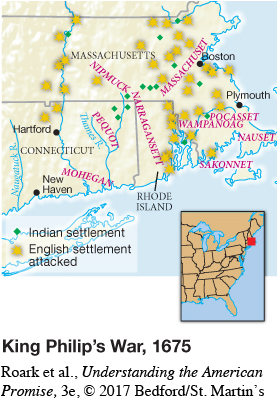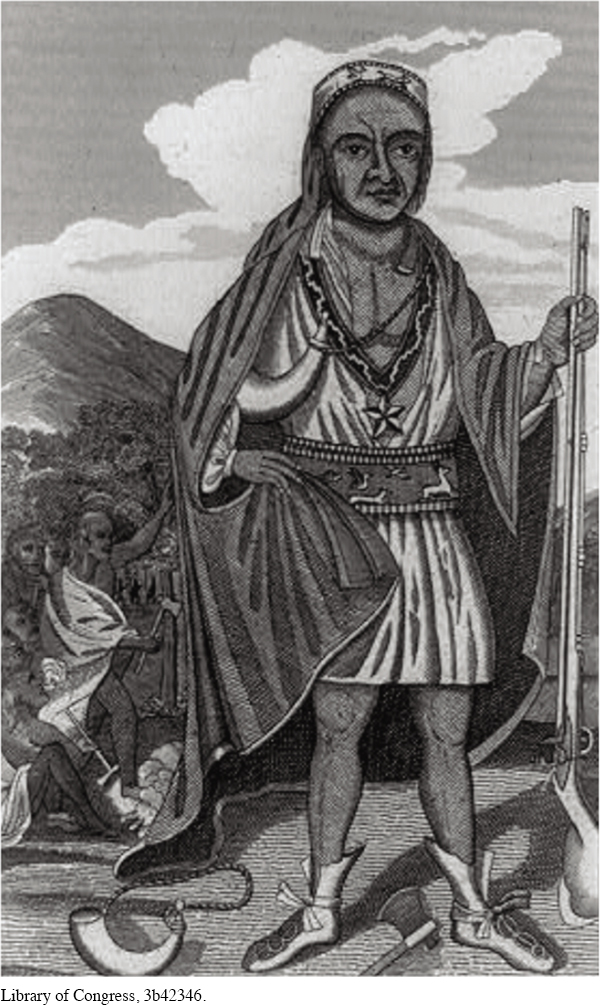King Philip’s War and the Consolidation of Royal Authority

The monarchy also took steps to exercise greater control over colonial governments. Virginia had been a royal colony since 1624; Maryland, South Carolina, and the middle colonies were proprietary colonies with close ties to the crown. The New England colonies possessed royal charters, but they had developed their own distinctively Puritan governments. Charles II, whose father, Charles I, had been executed by Puritans in England, took a particular interest in harnessing the New England colonies more firmly to the English empire. The occasion was a royal investigation following King Philip’s War. [[LP Spot Map: SM04.01 King Philip’s War, 1675/
A series of skirmishes in the Connecticut River valley between 1636 and 1637 culminated in the Pequot War when colonists massacred hundreds of Pequot Indians. In the decades that followed, New Englanders established relatively peaceful relations with the more potent Wampanoags, but they steadily encroached on Indian land. In 1642, a native leader urged warring tribes to band together against the English. “We [must] be one as they [the English] are,” he said; “otherwise we shall be gone shortly, for . . . these English having gotten our land, they with scythes cut down the grass, and with axes fell the trees, and their cows and horses eat the grass, and their hogs spoil our clam banks, and we shall all be starved.”
Such grievances accumulated until 1675, when the Wampanoags led by their chief Metacomet—whom the colonists called King Philip—attacked English settlements in western Massachusetts. Militias from Massachusetts and other New England colonies counterattacked the Wampanoags, Nipmucks, and Narragansetts in a deadly sequence of battles that killed more than a thousand colonists and thousands more Indians. The Indians destroyed thirteen English settlements and partially burned another half dozen. Mary Rowlandson, a minister’s wife in Lancaster, Massachusetts, who was captured by Indians, recalled later that it was a “solemn sight to see so many Christians lying in their blood . . . like a company of sheep torn by wolves. All of them stripped naked by a company of hell-hounds, roaring, singing, ranting and insulting, as if they would have torn our very hearts out.” [[LP Photo: P04.10 Metacomet /

By the spring of 1676, Indian warriors ranged freely within seventeen miles of Boston. The colonists finally defeated the Indians, principally with a scorched-earth policy of burning their food supplies. But King Philip’s War left the New England colonists with a large war debt, a devastated frontier, and an enduring hatred of Indians. “A Swarm of Flies, they may arise, a Nation to Annoy,” a colonial officer wrote in justification of destroying the Indians; “Yea Rats and Mice, or Swarms of Lice a Nation may destroy.”
> CONSIDER CAUSE AND EFFECT
What factors led the British monarch to create the Dominion of New England in 1686?
In 1676, an agent of the king arrived to investigate whether New England was abiding by English laws. Not surprisingly, the king’s agent found all sorts of deviations from English rules, and the monarchy decided to govern New England more directly. In 1684, an English court revoked the Massachusetts charter, the foundation of the distinctive Puritan government. Two years later, royal officials incorporated Massachusetts and the other colonies north of Maryland into the Dominion of New England. To govern the dominion, the English sent Sir Edmund Andros to Boston. Some New England merchants cooperated with Andros, but most colonists were offended by his flagrant disregard of such Puritan traditions as keeping the Sabbath. A visiting Englishman claimed that Bostonians were “great Censors of other Men’s Manners, but extremely careless of their own.” Worst of all, the Dominion of New England invalidated all land titles, confronting landowners in New England with the horrifying prospect of losing their land.
Events in England, however, permitted Massachusetts colonists to overthrow Andros and retain title to their property. When Charles II died in 1685, he was succeeded by his brother James II, a zealous Catholic. James’s aggressive campaign to appoint Catholics to government posts engendered such unrest that in 1688 a group of Protestant noblemen in Parliament invited the Dutch ruler William III of Orange, James’s son-in-law, to claim the English throne.
When William III landed in England at the head of a large army, James fled to France, and William III and his wife, Mary II (James’s daughter), became corulers in the relatively bloodless “Glorious Revolution,” reasserting Protestant influence in England and its empire. Rumors of the revolution raced across the Atlantic and emboldened colonial uprisings against royal authority in Massachusetts, New York, and Maryland.
In Boston in 1689, rebels tossed Andros and other English officials in jail, destroyed the Dominion of New England, and reestablished the former charter government. New Yorkers followed the Massachusetts example. Under the leadership of Jacob Leisler, rebels seized the royal governor in 1689 and ruled the colony for more than a year. That same year in Maryland, the Protestant Association, led by John Coode, overthrew the colony’s pro-Catholic government, fearing it would not recognize the new Protestant king.
But these rebel governments did not last. When King William III’s governor of New York arrived in 1691, he executed Leisler for treason. Coode’s men ruled Maryland until the new royal governor arrived in 1692 and ended both Coode’s rebellion and Lord Baltimore’s proprietary government. In Massachusetts, John Winthrop’s city on a hill became another royal colony in 1691. The new charter said that the governor of the colony would be appointed by the king rather than elected by the colonists’ representatives. But perhaps the most unsettling change was the new qualification for voting. Possession of property replaced church membership as a prerequisite for voting in colony-wide elections. Wealth replaced God’s grace as the defining characteristic of Massachusetts citizenship.
Colonists chafed under increasing royal control, but they still valued English protection from hostile neighbors. Colonists worried that the Catholic colony of New France menaced frontier regions by encouraging Indian raids and by competing for the lucrative fur trade. Although French leaders tried to buttress the military strength of New France during the last third of the seventeenth century to block the expansion of the English colonies, most of the military efforts mustered by New France focused on defending against attacks by the powerful Iroquois. However, when the English colonies were distracted by the Glorious Revolution, French forces from the fur-trading regions along the Great Lakes and in Canada attacked villages in New England and New York. Known as King William’s War, the conflict with the French was a colonial outgrowth of William’s war against France in Europe. The war dragged on until 1697 and ended inconclusively in both Europe and the colonies. But it made clear to many colonists that along with English royal government came a welcome measure of military security.
> QUICK REVIEW
Why did the Glorious Revolution in England lead to uprisings in the American colonies?
Understanding the American Promise 3ePrinted Page 99
Section Chronology